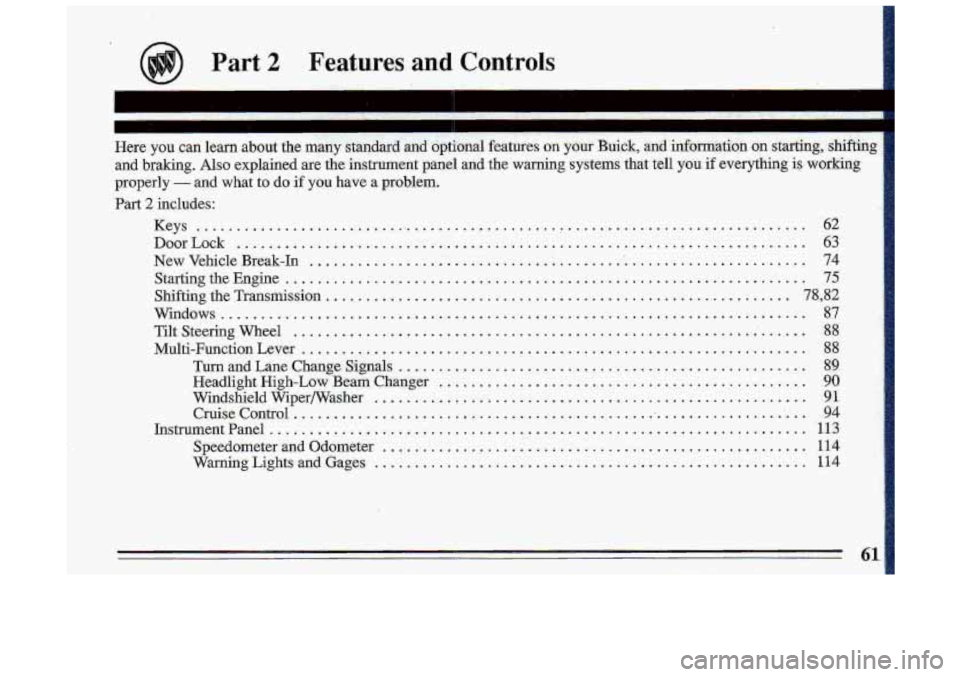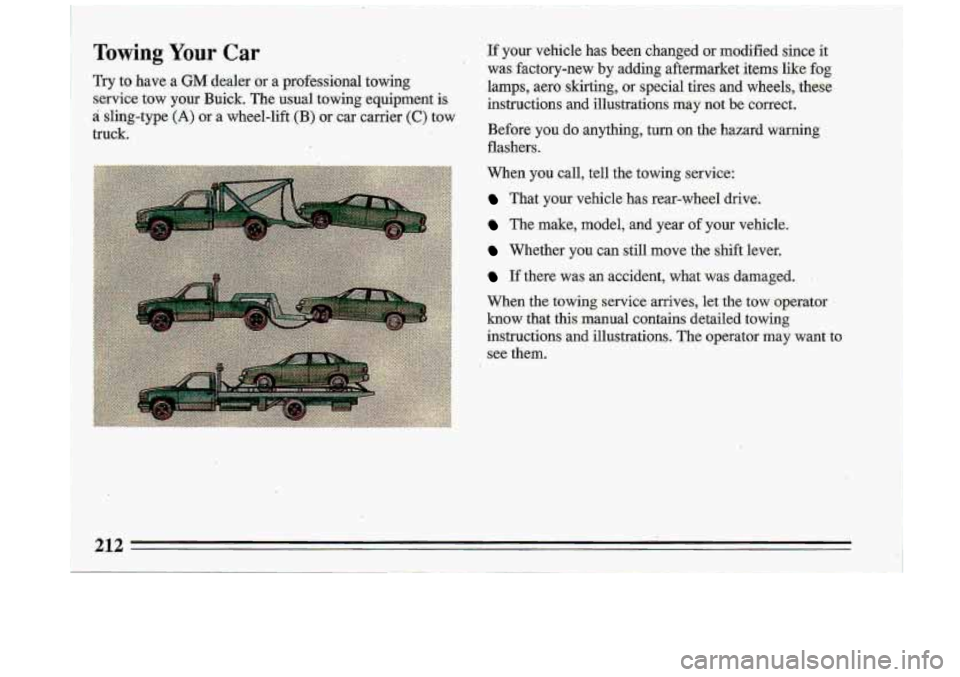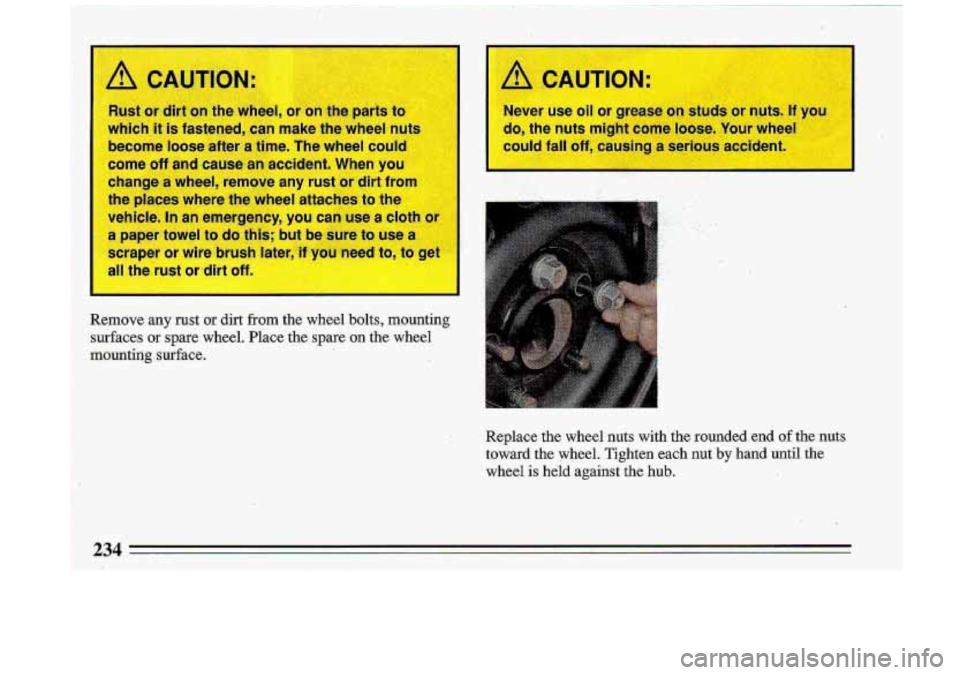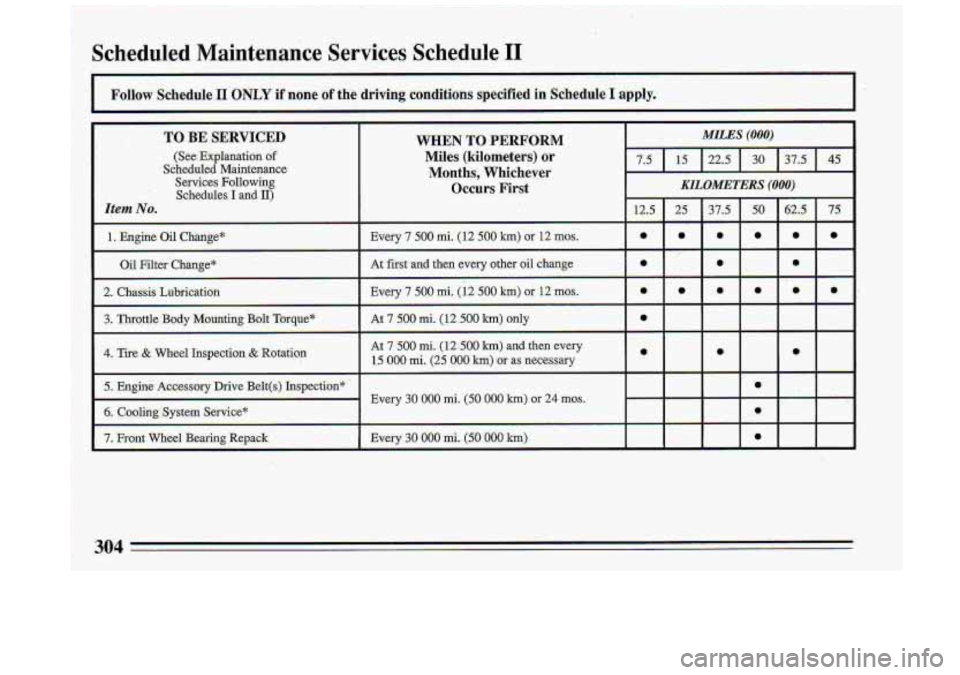1993 BUICK ROADMASTER change wheel
[x] Cancel search: change wheelPage 63 of 340

Part 2 Feat.ures and Controls
n .
Here you can learn about the many standard and optional features on your Buick, and infom.ation on starting. shifting
and braking
. Also explained are the instrument panel and the warning systems that tell you if everything is working
properly
. and what to do if you have a problem .
Part 2 includes:
Keys
........................................................................\
..... 62
DoorLock ....................................................................... \
63
New Vehicle Break-In ............................................................... 74
Starting the Engine
................................................................. 75
Shifting the Transmission
.......................................................... 78, 82
Windows ........................................................................\
. 87
TiltSteeringWheel
................................................................ 88
Multi-IFunctionLever ............................................................... 88
TurnandLaneChangeSignals ................................................... 89
Headlight High-Low Beam Changer .............................................. 90
Windshield WiperWasher
....................................................... 91
Cruise Control
.................................................................. 94
Instrument Panel
................................................................... 1 13
Speedometer and Odometer
..................................................... 114
Warning Lights and Gages
...................................................... 114
61
.
Page 96 of 340

Cruise Control (Option) ,* .. :. .> ..
..
";. ?y . ..
I you can't drive safely at a steady speed.
So, don't use your Cruise Control on
winding roads or
in heavy traff'
Cruise Control can be dangerous
slippery roads. On such roads, fast
changes in tire traction can cause
needless wheel spinning, and you
COI
lose control. C tt I ~ = P ise ^ontrol on
I
lippel- poads
With Cruise Control, you can maintain a speed of about To Set. Cruise Cc-trol
25 mph (40 km/h) or more without keeping your foot on 1. Move the Cruise
the accelerator. This can really help on long trips. Cruise Co\
ntrol switch 'to
"ON."
Control does not work at speeds below about 25 mph ;.'
When you apply your brakes, the Cruise Control shuts i. 'I
.Off.
NOTE: On the Estate Wagon, if the tailgate window is
not completely closed the cruise control will not work.
(40 k-yn/h).
Page 201 of 340

Driving with a Trailer
Towing a trailer requires a certain amount of experience. Before setting out for the open road, you’ll want to get
to
know your rig. Acquaint yourself with the feel of
handling and braking. with the added weight of the
trailer. And always keep in mind that the vehicle you are
driving is now
a good deal longer and not nearly so
responsive as your vehicle is by itself.
Before you start, check the trailer hitch and platform,
safety chains, electrical connector, lights, tires and
mirror adjustment.
If the trailer has electric biakes, start
your yehicle and trailer moving and then apply the
trailer brake controller by hand to be sure the- brakes are
working. This lets you check your electrical connection
at the same time.
During your trip, check occasionally to
be sure that the
load
is secure, and that the Lights.and any trailer brakes
are .still working.
Following Distance
Stay at least twice as far behind the vehicle ahead as you
would when driving your vehicle without a trailer. This
can help
you avoid situations that require heavy braking
and sudden turris.
.
Passing
You’ll need. more passing distance up ahead when
you’re towing a trailer. And, because you’re a good deal \
longer, you’ll need to go much farther beyond the
.
passed vehicle before you can return to your lane.
Backing Up
Hold the bottom of the steering wheel with one hand.
Then, to move the trailer
to the left, just move that hand
to the left.
To mo.ve the trailer to the right, move your
hand to the right. Always back up slowly and, if
possible, have someone guide
you.
Making Turns
When you’re turning with a trailer, make wider turns
than normal.
Do this so your trailer won’t strike soft
shoulders, curbs, road signs, trees, or other objects.
Avoid jerky or sudden maneuvers. Signal well in
advance.
Turn Signals When Towing a Trailer
When you tow a trailer, your vehicle has to have .a
different turn signal flasher and extra wiring. The green
arrows on your instrument panel will
flash whenever
you signal a
turn or lane change. Properly hooked up,
199
Page 214 of 340

Towing Your Car
Try to have a GM dealer or a professional towing
service tow your Buick. The usual towing equipment is
a sling-type (A) or a wheel-lift (B) or car carrier (C) tow
truck.
If your vehicle has been changed or modified since it
was factory-new
by adding aftermarket items like fog
lamps, aero skirting, or special
tires and wheels, these
instructions and illustrations may not
be correct.
Before you do anything, turn on the hazard warning
flashers.
When you call, tell.the towing service:
That your vehicle has rear-wheel drive.
The make, model, and year of- your vehicle.
Whether you can still move the shift lever.
If there was an accident, what was damaged.
When the towing service arrives, let the
tow operator
know that this manual contains detailed towing
instructions and illustrations. The operator may want to
see them.
Page 236 of 340

CAUTIO A
Rust or dirt on the wheel,
which it
is fastened, can make the wheel nu
become loose after a time. The wheel could
come
off and cause an accident. When you
change
a wheel, remove any rust or dirt fro1
the places where the wheel attaches to the
vehicle. In an emergency, you can use
a cloth or
a paper towel to
do this; but be sure to use a
scraper or wire brush later, if you need to, to get
all the r---t or dirt off.
N use oil or gre
e on stu
Remove any rust or dirt fro-rn the wheel bolts, rnoullLl1lg
surfaces or spare wheel. Place the spare on the wheel
mounting surface.
Replace.
the wheel nuts with the rounded end of the nuts
toward the wheel. Tighten each nut by hand until the
wheel is held against the hub.
234
Page 276 of 340

After the tires have beers rotated, adjust the front and
rea inflation pressure as shown on the Tire-Loading
Information label. Make certain that all wheel nuts ax9
properly tightened. See “Wheel Nut Torque” in the
’ ..
Index.
A CAUTION:
Rust or diir on a wheel, or on the parts to which
it is fastened, can make wheel nuts become
loose after a time. The wheel-could come off
‘and cause an accident. When you change a
wheel, remove any rust or dirt from places
where the wheel attaches to the vehicle.
In an
emergency, you can use a’cloth or a paper towel
to
do this; but be sure to use a scraper or wire
brush later,
if you need to, to get all the rust --
dirt off. (See “Changing a Flat Tire” in the
Index.)
I
When It’s Time for New Tires
One way to tell when it’s
time for new tires
is to.
check the treadwear’-
*. ’
indicators, which will
appear when your tires have only
2/32 inch (1.6 mm) or
less of tread remaining.
I
I
.’
DU need a new tire if
You can see the indicators at three places around the
tire.
You can see cord or fabric showing through the tire’s
The tread or sidewall is cracked, cut -or snagged deep
rubber.
enough to show cord or fabric.
The tire has a bump, bulge or .split.
274
Page 306 of 340

Sched.uled Maintenante Services Schedule I1
Follow Schedule. I1 ONLY if none of the driving conditions specified in Schedule I apply.
, TO BE SERVICED
(See Explanation of
Scheduled Maintenance Services Following Schedules
I and 11)
Item No.
I. Engine Oil Change"
Oil Filter Change"
2. Chassis Lubrication
3. Throttle Body Mounting Bolt Torque*
4. Tire & Wheel Inspection .& Rotation
5. Engine Accessory Drive Belt(s) Inspection*
6. Cooling System Service"
7. Front Wheel Bearing Repack.
WHEN TO PERFORM
Miles (kilometers)
or
Months, Whichever
Occurs First
, ..
I MILE,
KILOMEl
12.5 I 25 I 37.5
Every 7 500 mi. (12 500 km) or 12 mos. a 0 0
At first and then every other oil change a 0
Every 7 500 mi. (12 500 km) or 12 mos. 0 a 0
At 7 500 mi. (12.500 km) only 0
At 7 500 mi. (12 500 km) and then every
15 000 mi. (25 000 km) or as necessary Io
-~
Every 30 000 mi. (50 000 km) or 24 mos.
t ~~ .. Every 30 000 mi. (50 '000 km) ' ' '
; (000)
30 I 37.5 I 45
304
Page 309 of 340

7.
8.
To help ensure-proper operation, we recommena a
pressure test of both’the cooling system and the
pressure cap. If you do not use your vehicle under any of these
conditions, change both the fluid and filter every
100,000 miles (1 60 000 km).
Front Wheel Bearing Repack - When your 9. Spark Plug Replacement* - Replace spark plugs
vehicle is used in such service as police work, as a with the proper type. See “Specifications Chart.’’ in
taxi or
in door-to-door delivery, clean and repackthe the Index.
front wheel bearings at each brake relining or
15,000 Spark plug Wire Inspection*? - Inspect for
miles (25 000 km), whichever comes first. If you
don’t use your vehicle in such service, clean
and
repack the bearings at each brake relining or 30,000 -
miles (50 000 km) whichever comes first. burns, cracks .or other damage. Check the boot fit
at
the distributor and at the spark plugs. Replace wires
as. needed.
Transmission Service - Change both the fluid and
filter every
15,000 miles (25 000 km) if the vehicle
is mainly driven under one or ‘more
of these
conditions:
In heayy city traffic where the outside
temperature regularly reaches
‘90 OF (32 C) or
higher.
In hilly or mountainous terrain.
When doing frequent trailer towing.
Uses such as found in taxi, police car or delivery
service.
11. Exhaust Gas Recirculation (EGR) System
Inspection*?
- Conduct the EGR system service
as described in the service manual.
To purchase a
service manual, see “Service Publications” in the
Index.
12. Air Cleaner Filter Replacement* - Replace every
30,000 miles (50 000 km) or more ofkn under dusty
conditions. Ask your dealer for the proper
replacement intervals for your driving conditions.
307
I